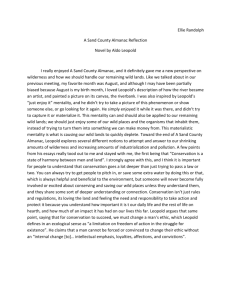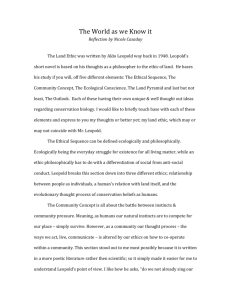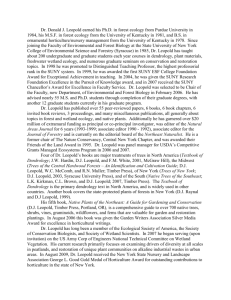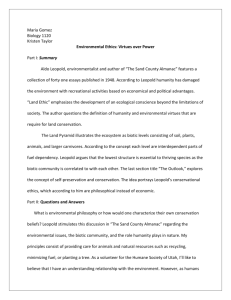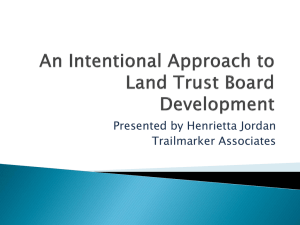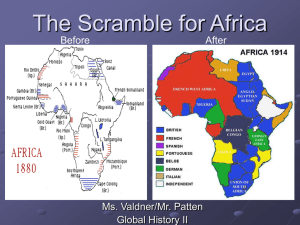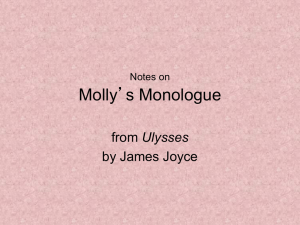Chapter 2
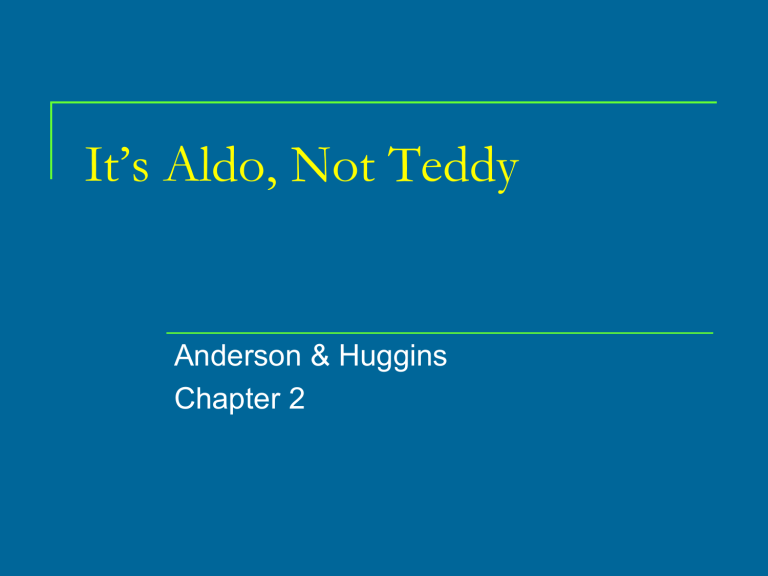
It’s Aldo, Not Teddy
Anderson & Huggins
Chapter 2
Growth vs. Conservation?
Americans have had a complex relationship with nature.
On the one hand, we have exploited the nation’s natural resources by clearing forests, damming rivers, and plowing the prairies.
On the other hand, we have Henry David Thoreau to
John Muir to Aldo Leopold to Theodore Roosevelt who have raised our environmental consciousness.
A tension between economic growth and environmental quality,
Which of these environmental leaders has offered the best ideas for resolving such tensions?
2
Conservative Environmentalists
Conservative environmentalists have had to overcome a reputation for putting growth before environmental stewardship
America’s conservative movement was once intimately linked with conservation.
This chapter explores the philosophical foundations for free market environmentalism and conservation.
3
TR: Godfather of
Natural Resource Socialism
Many conservatives are quick to declare
President Theodore Roosevelt the godfather of conservation.
TR was no conservative conservationist.
His action firmly ensconced natural resource socialism as a mainstay of environmental management.
What about Richard Nixon?
More resource socialism.
4
Aldo Leopold
Environmentalists claim Aldo Leopold as the icon of modern conservation because he called for a heightened environmental consciousness in the form of a “land ethic” to encourage resource stewardship.
Because it is difficult to develop such a heightened consciousness, most environmentalists call for command-and-control policies to force said consciousness.
Leopold’s land ethic inadvertently became the basis for environmental regulation.
5
Leopold and FME
Leopold knew that wolf extirpation was wildlife execution by government.
Leopold might be thought of as the first free market environmentalist.
Understood the importance of incentives.
The key role of the private property owner.
6
Demand for Conservation
Both the concern over scarce resources and the demand for amenities lead to more governmental regulation in the name of conservation.
Many feared that Americans were consuming natural resources at an unsustainable rate.
TR decided resources were to be governed by new land management agencies such as the Forest
Service on behalf of the public to achieve the impossible goal of producing “the greatest good for the greatest number.”
7
King Teddy’s Bequest
Progressives argued that the economy, society, and government were riddled with inefficiency and that centralized control by experts could identify and fix the problems.
They believed that scientifically managing natural resources would enable experts to manage for the masses.
8
Elites: Put Experts in Charge
Under the banner of scientific management, much of the West’s public land was put under the control of Washington politicians, subordinating local communities and business interests to the federal bureaucracy.
During his presidency, Roosevelt set aside
194 million acres (the size of Texas and
Louisiana combined).
9
Critics of TR’s Progressivism
John Muir viewed progressivism as a negative because, in his words, the “greatest number is too often found to be number one.”
A Colorado newspaper lambasted
Roosevelt’s conservation efforts as “Russian policy,” which was nothing more than
“arbitrary and authoritarian rule on the range.”
10
Roosevelt’s Heir: Nixon 1969-1974
Environmentalists who organized the first
Earth Day viewed humanity as a threat to the health of the earth.
They demanded much broader protection for overall environmental quality.
Nixon recognized that by committing his administration to regulate the environment he could become greener than thou and gain political currency in the process.
11
Nixon’s Legacy: Bureaucratic Morass
It is easy to overlook Nixon’s impact on the emerging environmental movement in
America.
Nixon’s unprecedented bureaucratic morass includes the
National Environmental Policy Act (NEPA)
Clean Air and Clean Water Acts
Environmental Protection Agency (EPA)
Endangered Species Act
12
Environmental Impact Statements
NEPA, often referred to as the environmental
Magna Carta, has turned out to be the most influential of the many environmental laws enacted in the 1960s and 1970s.
The average length of an environmental impact statement (EIS) is 570 pages.
It can take years to review it.
Under NEPA, outside groups who are not directly affected by a proposed project are often accorded more importance than local interests.
13
Nixon’s Legacy
The benefits of complying with Nixon-era regulations are outweighed by the tremendous costs.
“The best estimates are that we could have achieved the present level of environmental quality at a quarter of the direct cost. . . . [T]he current regime of pollution control also creates immense indirect costs, by imposing paper work requirements and by discouraging new plants and innovations”
14
Top-Down Regulations
Although Roosevelt’s and Nixon’s intentions may have been good….
Beginning with Roosevelt’s presidency environmental policy has focused on top-down governmental regulations, with little attention to the knowledge and skills of local resource users.
As Leopold asked, “At what point will governmental conservation, like the mastodon, become handicapped by its own dimensions?”
(1966, 250).
15
Aldo Knows Best
One of the first to raise concerns over natural resource socialism was Aldo Leopold.
Metaphor of government as a meadowlark to explain problem of progressive conservation.
Leopold’s bird dog, Gus, when he couldn’t find pheasants, became excited about meadowlarks.
This “whipped-up zeal for unsatisfactory substitutes masked the dog’s failure to find the real thing,” temporarily calming the dog’s inner frustration.
16
17
Meadowlarks are Not Pheasants
The meadowlark symbolized “the idea that if the private landowner won’t practice conservation, let’s build a bureau to do it for him.”
Like the meadowlark, explains Leopold, this substitute has its good points and often smells like success.
The trouble is “it contains no device for preventing good private land from becoming poor public land….”
He concluded by cautioning the reader to be leery of the belief that “whatever ails the land, the government will fix it.”
18
Father of Wilderness Conservation
Leopold came to realize that true environmental protection would be organized around “a conviction of individual responsibility for the health of the land.”
He believed that those who owned the land were the best stewards because they understood the land’s complexity.
19
Leopold: Stewardship
Leopold grew up in Burlington, Iowa in a culture where private land ownership, free enterprise, and individualism were prized.
Leopold recognized the importance of private landowners as stewards and the difficulty of creating a land ethic in governmental bureaucracies.
20
Conservation Economics
Leopold critiqued the effectiveness of conservation through public ownership and governmental agencies.
He described conservation “experts” as working at cross-purposes.
He suggested that economic incentives might be used to reward good stewardship by private individuals.
21
Lean and Green
The type of private stewardship that Leopold called for was in place well before the federal government got involved.
Examples abound.
Boone and Crockett Club
Ravenna Park
Huron Mountain Club
Grandfather Mountain in North Carolina
Yellowstone National Park
22
Public vs. Private
If Leopold was correct —that individuals have the greatest responsibility and incentive to exercise stewardship over their land —then the task is to promote institutional arrangements that enable and encourage grass-roots conservancy.
Caught up in the competition, greener-than-thou policymakers lose sight of the fact that regulatory environmentalism has a less-thanstellar track record.
23
ESA
As a result of contrived incentive structures, environmental “improvements” have sometimes created perverse results.
The ESA allows the federal government to control private lands where listed species are found, creating an incentive for landowners to destroy species and habitat to head off burdensome regulations.
Because natural resource socialism turns RCWs into a liability, landowners, like any rational investor, try to minimize them.
24
Preble’s Meadow Jumping Mouse
University of Michigan scientists concluded that the 1998 listing of the Preble’s Meadow jumping mouse prompted a backlash against the species.
“So far, listing the Preble’s under the ESA does not appear to have enhanced its survival prospects on private land.”
Landowners’ detrimental actions canceled out the efforts of landowners seeking to help the species.
25
26
Leopold’s Legacy
Leopold was ahead of his time in realizing that incentives are more effective when they come in the form of a market carrot rather than a regulatory stick.
“Conservation,” he said, “will ultimately boil down to rewarding the private landowner who conserves the public interest” (1934, 202).
As he might have predicted, agricultural subsidies led to more intensive farming using more water, fertilizer, and pesticides —all with adverse environmental consequences —hardly the kind of “rewards” that
Leopold had in mind.
27
Joining the Green Crusade
It is not surprising that Democrats have embraced regulations and subsidies as the way to direct private interests.
It is surprising that Republicans have followed this track.
As Steven Hayward, a scholar at the American
Enterprise Institute, points out, “the environment is for conservatives what defense is for liberals: they don’t feel comfortable with it”
28
Conclusion: Beyond Regulation
We need to harness the same private incentives that drive America’s economic engine to drive the environmental engine.
This means rewarding rather than penalizing private stewardship.
Aldo Leopold should be admired by everyone for his “conservation economics.”
Following Leopold, we need to move beyond greener-than-thou environmental regulation to achieve practical solutions through free market environmentalism.
29
